|
|
 |
|
|
Gustavus Adolphus is coming back!
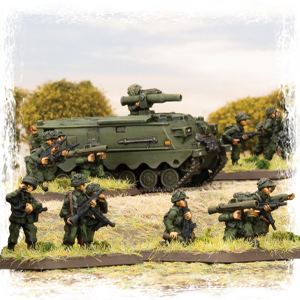 |
Gustavus Adolphus is coming back!
By Livio Tonazzo
Thanks to the new book Nordic Forces, Sweden makes its appearance in World War III: Team Yankee!
And here is the base for a list that I am going to propose to you:
|
|
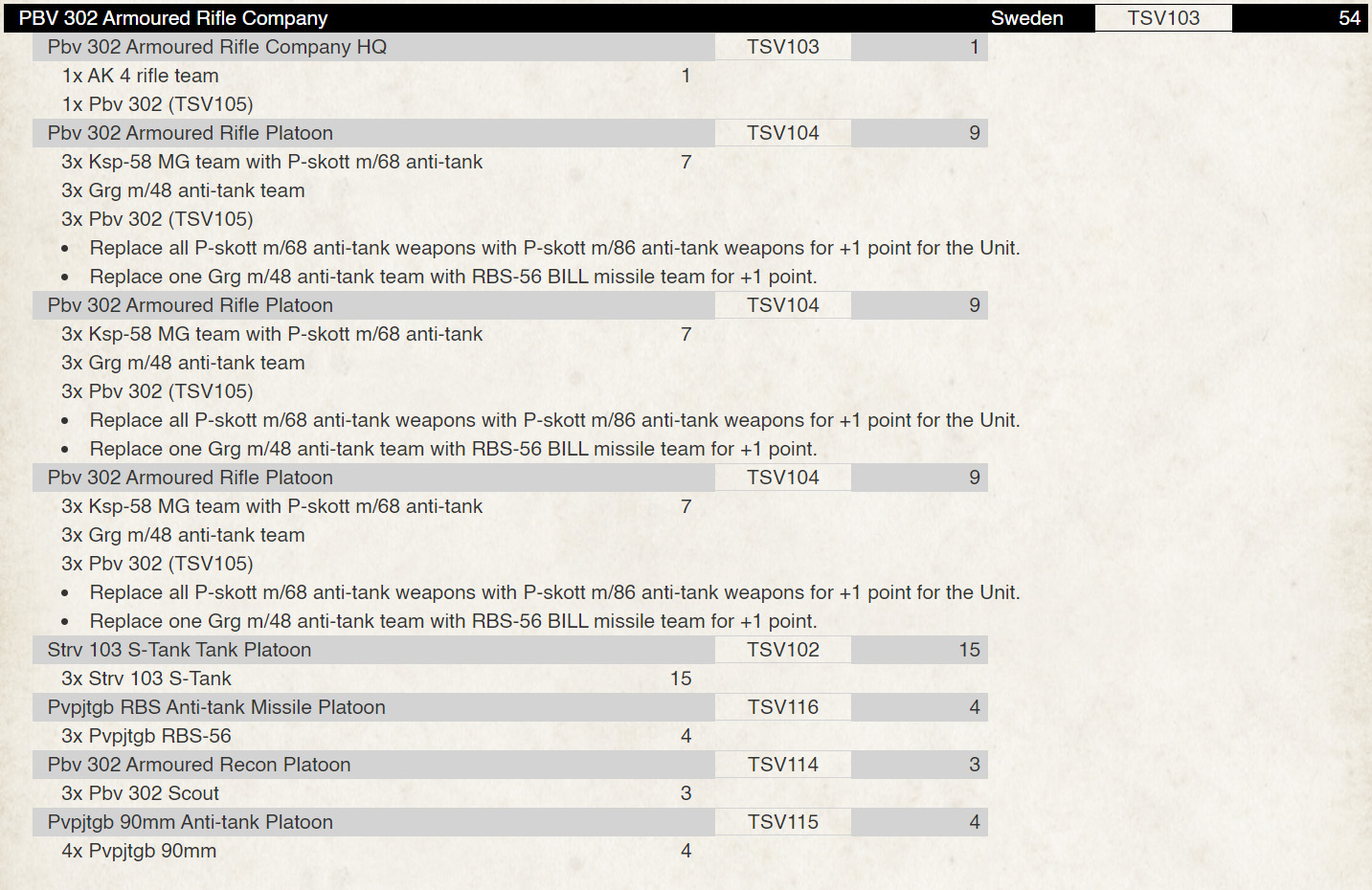
|
|
The list is built around a solid core of infantry that takes up nearly 30% of the army. It may come as little surprise that an infantry-focused Force adopts this choice, but if you look at the lists commonly encountered on battlefields it is so obvious. In fact, many NATO nations deploy the minimum of mandatory infantry, usually a couple, see for example the British or the Americans. Others, on the other hand, deploy only one having the possibility of putting tanks as a second compulsory unit, the West Germans. The Swedes on the other hand, in my opinion, cannot leave the house without three large infantry blocks. Why? Because it is one of the best infantry in the game. Let's find out why.
|
|
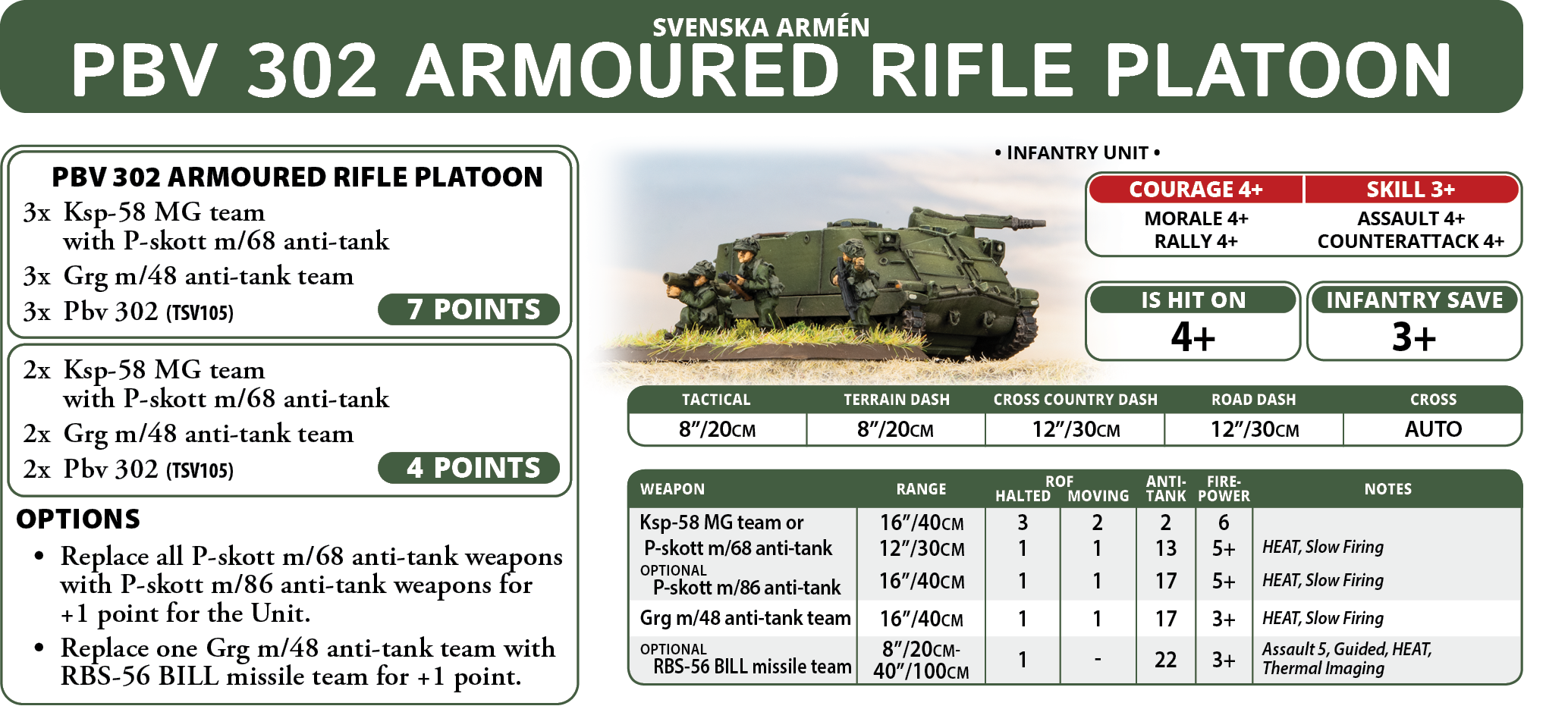
|
|
A PBV 302 Armored Rifle Platoon consists of 3 Ksp-58 MG teams with P-skott m/68 anti-tank and 3 Grg m/48 anti-tank teams for a total of 6. All in all, it's not that small a platoon. The 3 Ksp-58 MG teams are MG teams, therefore, they can fire 3 shots from halted and 2 shots from moving (or pinned). It is, in my opinion, the best infantry team in the game as it can develop a good volume of fire both stationary and on the move. Even if the pinned platoon can repel an assault on its own, this is a considerable advantage.
|
|
Furthermore, each team is equipped with a P-skott m/68 anti-tank and therefore can have an anti-tank weapon, even if not incredible. With an anti-tank value of 13 and a range of 12" it is a good weapon to destroy light vehicles but insufficient to worry heavy ones both from a distance and during assaults.
|
|
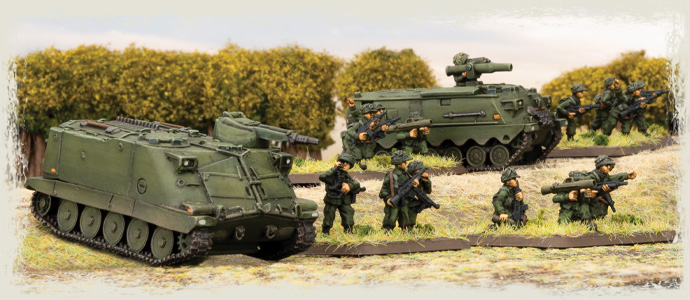
|
|
However, for a fraction of the price it is possible to choose a major upgrade, capable of changing the face of this infantry. In fact, all three infantrymen can replace the P-skott m/68 anti-tank with a P-skott m/86 anti-tank. Only one digit is reversed (from 68 to 86) but the anti-tank value goes from 13 to 17 while the range increases from 12“ to 16”. Firepower always stays at 5+ of course. This is a change capable of making infantrymen effective from a distance even against First Generation MBTs but above all that makes the platoon very difficult to assault. An Anti-tank value of 17 can also worry ERA or Chobbam armour, but above all, it is effective against all the others. In other words, Third Generation MBTs are needed to assault a full-strength Armored Rifle platoon.
|
|
The other 3 teams of the platoon are instead armed with the Grg m/48. A weapon very similar to the P-skott m/86 except for the non-negligible fact of having a Firepower of 3+. It is therefore a good six teams out of six armed with an anti-tank weapon at Anti-tank 17, of which three at firepower 5+ and three at firepower 3+. It will be quite difficult to be assaulted, also because both weapons can fire even if the unit is Pinned Down, despite having a +1 penalty due to the slow firing rule.
|
|
Additionally, one of the Grg m/48 anti-tank teams can be upgraded to an RBS-56 BILL missile team for a fraction of the cost. It is a missile (therefore minimum range 8" and maximum 40") with anti-tank 22. Excellent for engaging enemy tanks at long range. Certainly, the unit will lose something in anti-tank defence, but it will gain offensive capacity. It is a choice to make in my opinion.
|
|
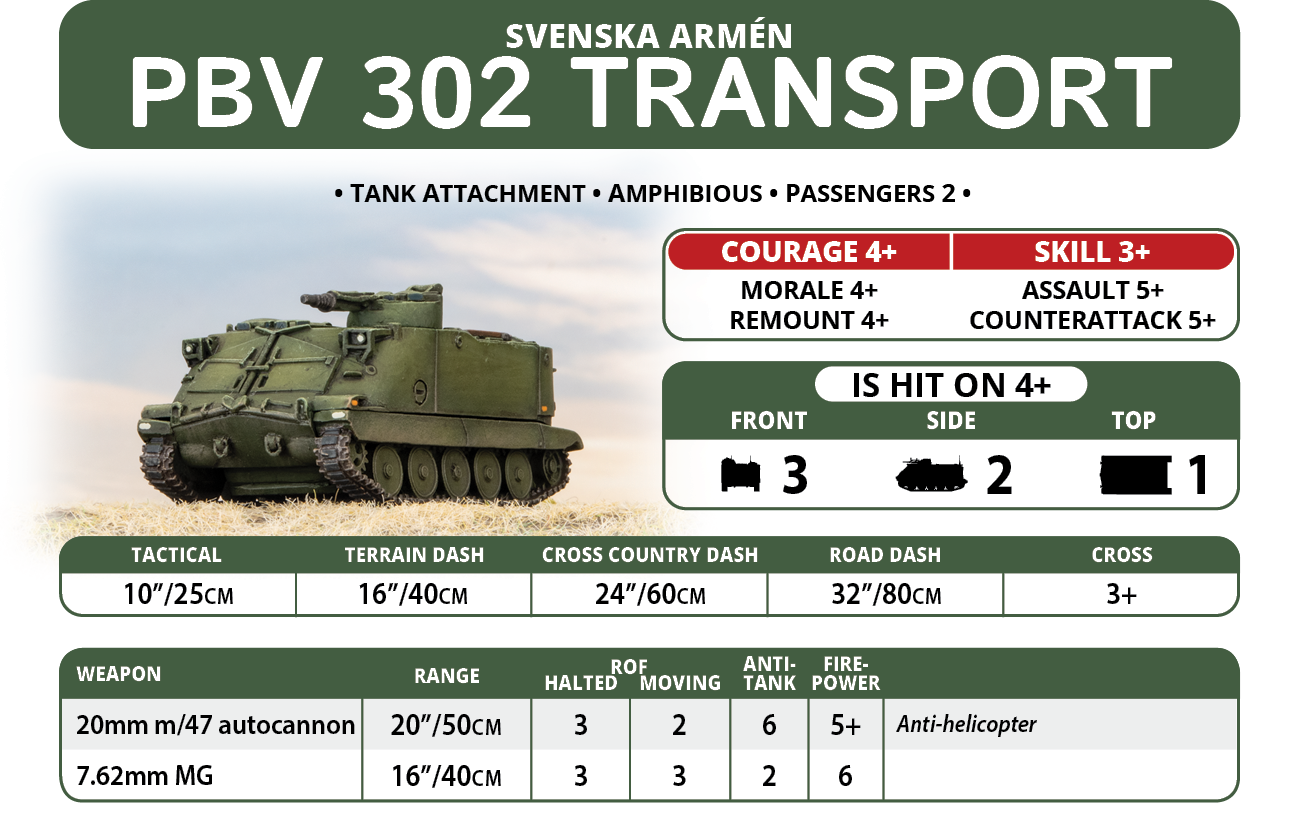
|
|
But that's not all because the (complete) unit can also count on three Pbv 302. They are essentially M113s both in terms of protection and mobility. The substantial difference concerns instead the armament. In addition to an MG, always useful for managing infantry, the Pbv 302 is armed with a 20mm m/47 autocannon. It is an excellent weapon, capable of firing 3 shots when the vehicle is Halted and 2 shots when the vehicle is moving at 20”. The anti-tank value is 6, which makes it excellent for handling lighter vehicles such as Shilkas, Spandrels, and BRDMs but also for worrying IFVs such as BMPs, BTRs and M113s. The Firepower of 5+ is a bit penalizing, but all in all, there is nothing to complain about.
|
|
I find it great because it can handle the BRT-60s that are often found on the battlefields, these vehicles have a worse gun (anti-tank 5) and above all a worse armour value (FA 1). Pbv 302 should be a great counter. Furthermore, the 20mm m/47 autocannon also has Anti-Helicopter. That's why Swedish infantry is great: they can develop good anti-infantry fire thanks to MG teams, good close-range anti-tank fire also in terms of quality with anti-tank 17, they have a chance to hit opponents at distance with anti-tank 22 thanks to a team and finally the transports are able to play a discrete anti-light vehicle role. Precisely for this reason I chose to play three large infantry platoons, for less than 30 points, I should have a core that is as resistant as it is versatile.
|
|
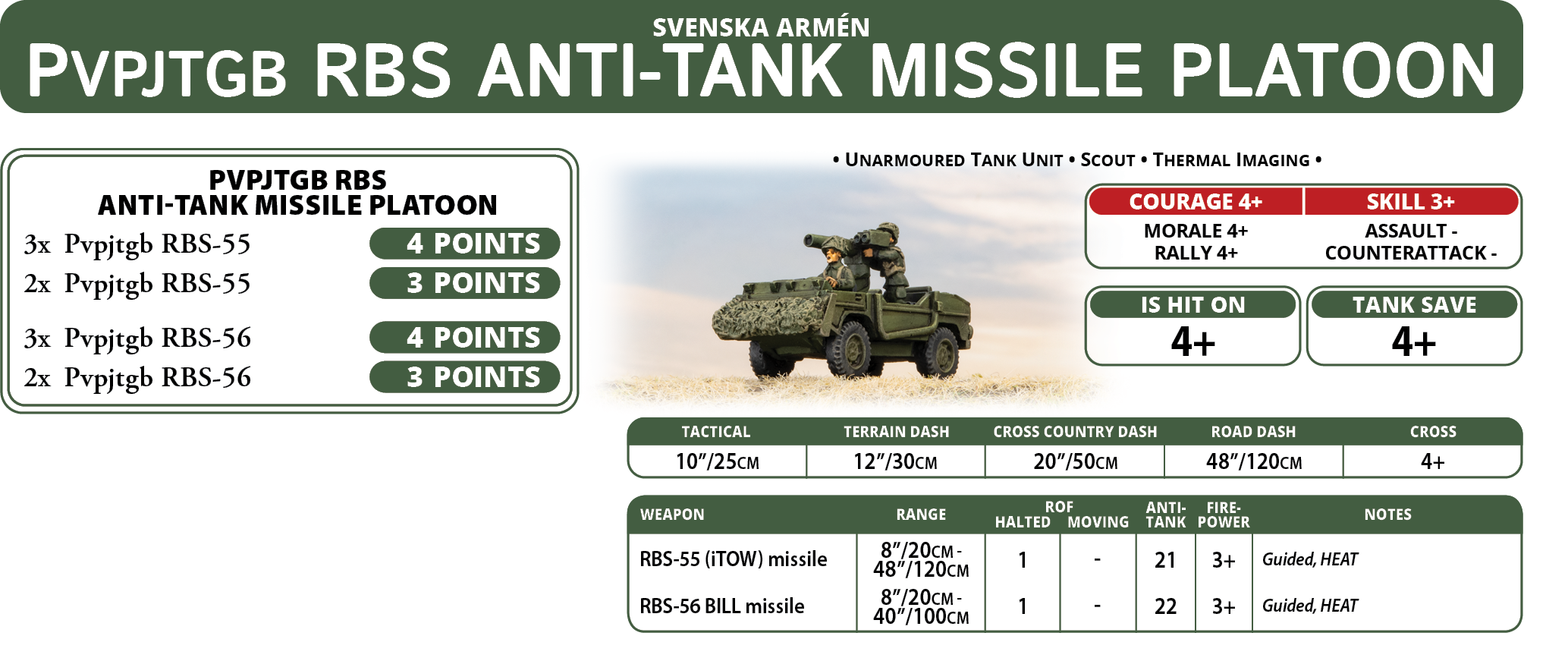
|
|
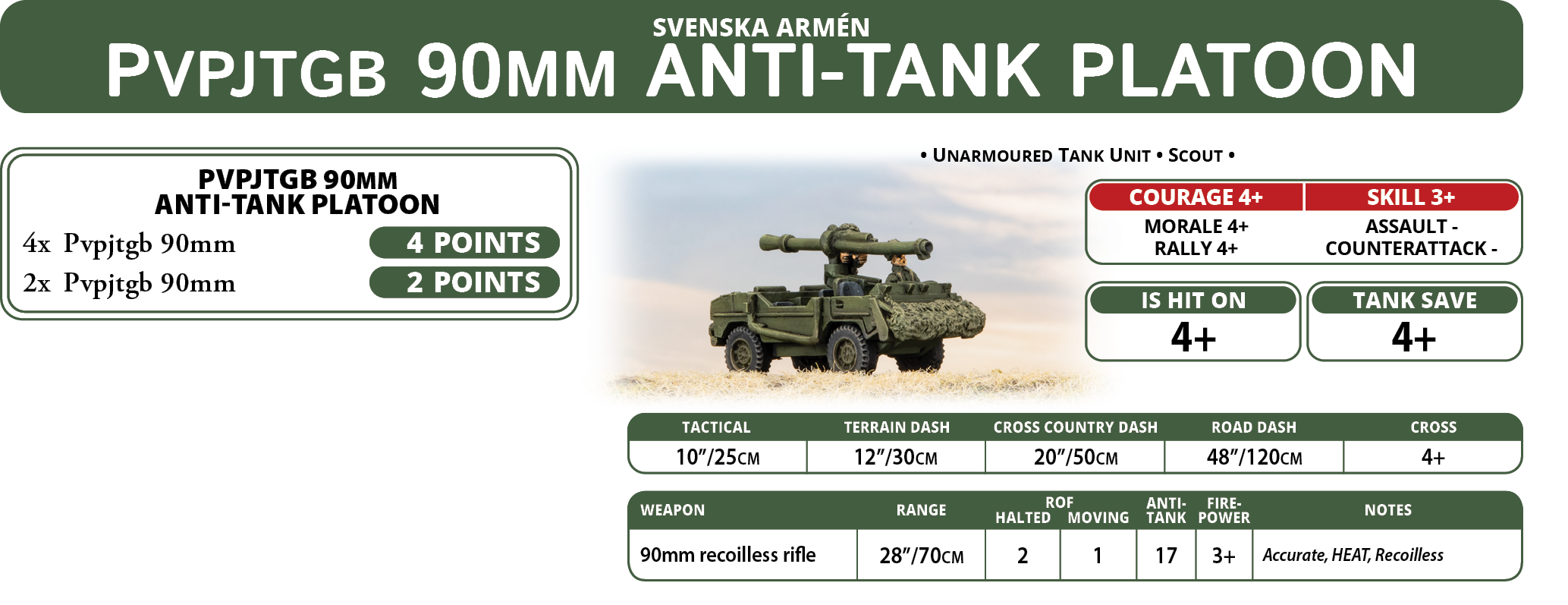
|
|
In addition to the infantry, however, there are also other units in formation, it is important to have numerous units in the Formations that prevent the Force from breaking, especially if there is only one Formation. To enhance the anti-tank component, I have deployed two dedicated platoons: the Pvpjtgb RBS ANTI-TANK MISSILE PLATOON and the Pvpjtgb 90mm ANTI-TANK PLATOON. These are similar platoons (jeeps shooting tanks) but with different roles.
|
|
The first is a platoon made up of 3 Jeeps capable of firing 3 anti-tank 22 missiles at a range of 40", while the second is made up of 3 jeeps capable of firing two shots each with their recoilless rifle (or 1 moving) with anti-tank 17 and Firepower 3+ with a range of 28”. The difference is obvious. The first is mainly used to destroy opposing MBTs, while the second can filter through the lines and hit lighter units causing serious damage. If the opportunity arises, it can even target some first-generation MBTs (Leopard 1, T-55, etc.). The cost of the two units is the same and both come for less than 10 points.
|
|
Some might ask why I preferred the Pvpjtgb RBS ANTI-TANK MISSILE PLATOON to the PVRBV 551 ANTI-TANK MISSILE PLATOON, which is a platoon of three Pbv 302s with only the mg and capable of launching TOW missiles at anti- tank 21. Being an armoured vehicle, they resist more against light hits, especially from mg, but less against heavy anti-tank hits. And this is the first reason. The second reason is that jeeps have the scout rule, which allows them to position themselves in relative safety and then roll the next turn. Considering they should operate from long range the advantage of staying gone to ground should be rewarded.
|
|
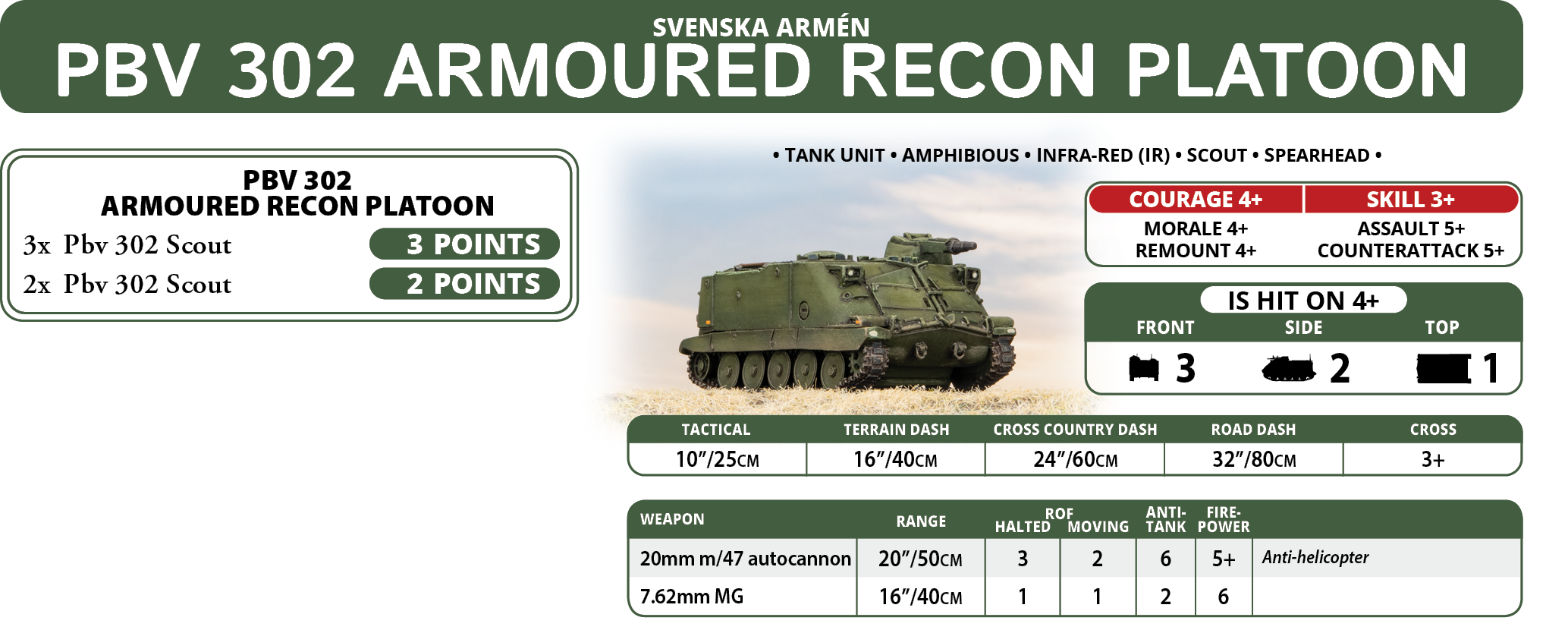
|
|
Inside the Formation, there is also space for an Armored Recon Platoon of 3 Pbv scouts. Units with the Spearhead rule are essential to make the most of the depth of the battlefield in some missions. Whether the Attack, Maneuver or Defend battle plan is chosen, the recce unit must be listed. The Pbvs are also excellent means thanks to the possibility of inflicting serious damage to light vehicles and troop transports so deploying some is never a bad idea.
|
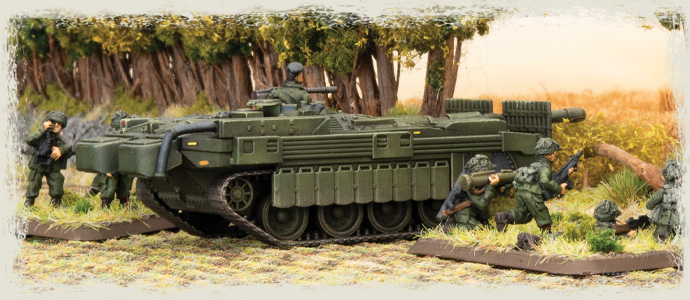 |
|
To complete the formation, a STRV 103 S-TANK PLATOON thinks that its three tanks that can shoot and remain gone to ground are particularly difficult if they play a defensive role. It is a tank that focuses on not being hit rather than on armour which is quite poor (Front Armor 12). On the other hand, the cannon is not bad at all as it can hit targets up to 48” away (not a common range at all) with an anti-tank value of 21 with a Firepower of 2+. The 105mm L74 gun is equipped with a laser rangefinder however it is at the same time overworked, confirming the mostly defensive capabilities of the vehicle.
|
|
At this point the lineup is complete. With 54 points we got a solid infantry base capable of handling both infantry and tanks, two anti-tank units on jeeps, one scout unit and one tank unit. You still have 46 points to decide how to decline your list. Attentive readers will realize that so far, we have not talked about artillery. In fact, the Pbv 302 Armored Rifle formation lacks the artillery slot which is not infrequent among NATO organizational charts. All that remains is to take it from the supports!
|
|
And here are the supports I chose for my list, it’s not the only option. I prefer a defensive approach here, but you can set the list in a different way.
|
|
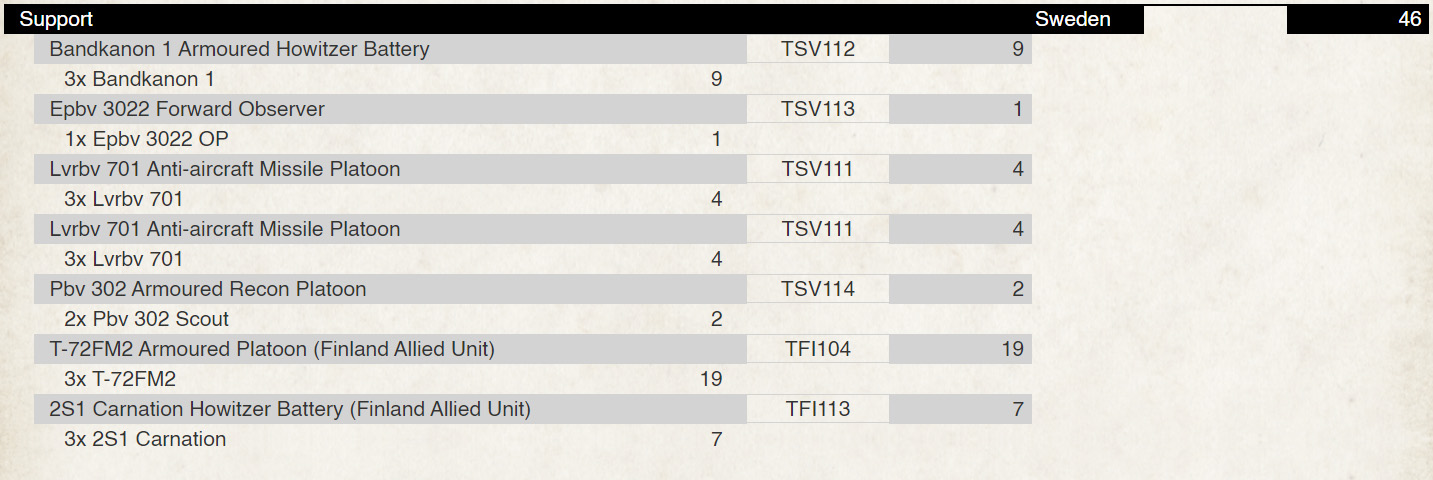
|
|
Precisely to make up for this lack, I chose two artillery, one of which belongs to the Finnish ally. The BandKanon 1 armoured howitzer is an incredible self-propelled artillery thanks to the autocannon rule, however, it can only take one battery. Precisely for this reason, a unit of Carnation will provide additional support at an honest cost. The spotter cannot miss to range in on the 3+ even if the template hits some terrain. The Carnations aren't the only Finnish allies. I also fielded a platoon of T-72fm2s as I wanted a more offensive tank, especially in assault. ERA armour seems like the right choice. The list is completed by two platoons of LVRBC 701 each consisting of 3 LVRBV 701 which have a profile similar to that of the M113 and are armed with anti-aircraft rockets at Firepower 5+. Despite the absence of Third Generation MBTs, having coverage against aircraft is important to prevent self-propelled artillery from being easily destroyed and losing effectiveness.
|
|
And that's it with that!
~ Livio
|
Last Updated On Thursday, August 31, 2023 by Ryan Smith
|
|
|